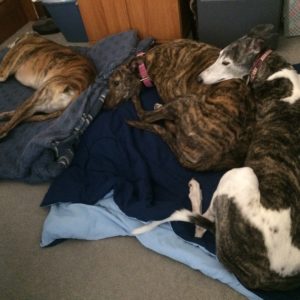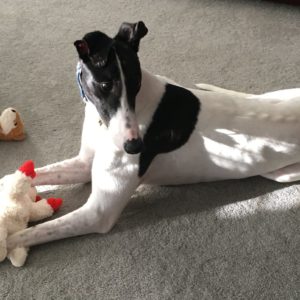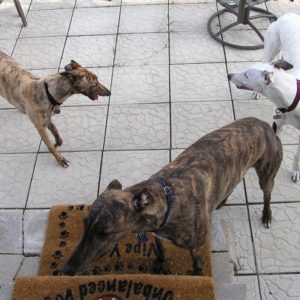- Upon receipt of your application, an adoption representative will email additional information to you; please check your spam folder if you do not receive an email within five business days. You will be contacted to schedule an in-person interview at the kennel once suitable hounds are available. The purpose of this visit is to ascertain that a greyhound is, indeed, a good choice for your family. This in not an interrogation but a reflection of our desire to make the best match for all concerned.
- Based on the interview and your family and lifestyle, we will have chosen the dogs in the kennel that would fit best with your family. Things we look at include: 1) Are there children in the family? 2) Do you have other pets? 3) How long would the dog be alone (some do better than others when alone). 4) Do you have a fenced yard, or will your dog be walked on a leash? 5) How much experience do you have with dogs? You may then choose from those dogs that are best suited for your family and, once approved, you will arrange to take your dog home. We ask that you allow at least an hour for this visit (some take much longer). At GAO, there are five acres for you to walk and spend time with your potential new family member (weather permitting).
$1,000 adoption fee – subject to change as expenses to obtain hounds increase
$15 for martingale collar and leash set
$10 for hanging water bucket
$1,025 TOTAL
Note that GAO has the lowest adoption fee among the greyhound groups we have surveyed. In comparison, dogs sold by breeders or pet stores (often mixed-breed) range from $1,500 to several thousand dollars. GAO is currently subsidizing, via donations and fund-raisers, the cost of more than $2,000 per hound to transport greyhounds from Ireland. This includes airfare, veterinary costs, broker’s fees, airport fees, a large wooden crate for each dog’s transport on the airplane, transport to the airport, etc. When they flew into Chicago, we needed hotel rooms as the round-trip was too much for one day, additional travel fees and more than $300 in gas for the trip with the trailer and dogs.
Circumstances have changed considerably in the U.S. over the last few years. The hounds here don’t need our help as racing has ended in most states, including Florida, where the majority of our greyhounds have come from over the years. The greyhounds from Ireland are in a completely different situation. There aren’t nearly enough homes there and an estimated 6,000 or more, per year never get homes.
Subsidizing the entire amount is impossible. The cost to get the hounds to the U.S. is just a portion of the cost. There are many other expenses such as food, treats, cleaning and laundry supplies for the kennel, propane to heat the kennel, air conditioning, insurance, softener salt, veterinary care, flea, tick and heartworm medications, utilities, printing and mailing, just to name a few.
Please do not ask us to reduce the fee for an older greyhound or one of the few that we may acquire from the tracks in West Virginia. Being an older or “local” greyhound does not make them a less valuable or loving pet. While some groups are charging an adoption fee that covers the entire cost to bring a greyhound from Ireland (we know not all adopters can do that), the $1,000 adoption fee covers less than half our expenses. When the adoption fee is paid for an older or local dog, the additional amount, if any over our expenses, helps us to cover a small portion of our overall expense.
As an example, we recently received a senior from someone in Pennsylvania whose adoption group has closed. His extensive dental cost $800 and a bout with illness was another $800+. We don’t charge a higher adoption fee for a dog like this, just as we don’t charge less for a dog whose initial expense isn’t as much as the Irish dogs. It still requires an incredible amount of work to raise the funds we need. At this point, we’ll need to hold off on helping more dogs from Ireland until we can catch up with the more than $130,000 it has cost to bring the 65 dogs we’ve received from Ireland between May 2022 and October 2023. Please help us to continue our work to find these loving dogs new homes, here in America!
Should you adopt, we wish you the best with your new greyhound. We’re always here for help or information!
In addition to everyday care and feeding prior to adoption, your greyhound will have:
- been spayed or neutered
- been updated on vaccinations (DHLP / Parvo and Rabies) if not current
- been tested for heartworm
- been dewormed
- had a complete dental cleaning and extractions, if necessary
- had a microchip implant for permanent identification
- been evaluated for temperament and behavior
- had any other necessary medical care
GAO will provide:
- Follow-up and assistance during the transition period and throughout the life of your greyhound
- Fun events, gatherings and volunteer opportunities to participate in with your greyhound
- Boarding at a nominal rate if you need to leave your greyhound in a kennel
- Lifelong support and financial assistance (if our financial position permits) in the case of catastrophic illness or injury when needed, however your ability to provide for your greyhound should be taken into consideration as part of the decision to adopt
As a breed, greyhounds are as good or better than most. However, we recognize that each dog is different and strive to help you pick the dog best suited to your family’s needs. Some will take a little time and patience to adjust to cats or other small animals.
- Not at all. Again, each dog is an individual. Many families have greyhounds of both gender and see no difference with regard to personality, tolerance, affection and gentleness.
- It’s our experience that many people request a female, when considering adoption. The sad fact is that boys are often misunderstood and, therefore, more difficult to place. While boys are rarely sent back to the farm after their racing days, girls are often sent to retire to the breeding farms, making the pool of available girls very small in relation to the number of boys we receive. It is not unusual for us to get twice to three times as many boys as girls when we take in new dogs.
- Contrary to what many people think, girls are not “nicer” than boys. Boys don’t live their lives lifting their legs on the furniture. They might try it, once or twice (they usually don’t) but during that first day in your home, you’ll be right there to correct him and let him know that outside is the place to do that.
- Greyhounds are very sensitive creatures and take correction very seriously. It’s one of the nicest things about them and part of what makes them such lovely companions. It only takes a time or two of hearing your unhappy voice for them to get the message.Boys are gentle, kind, loving and sensitive.
- Many adopters who’ve had both genders prefer to have boys, although we firmly believe each dog is different and each must be viewed in terms of his or her own personality. Our boys often wait, patiently, for many months, for the love of a family, while the girls “zip” out the door, shortly after they arrive. So, if you’re someone who has listed “small girl”, in answer to our question about preferences, please consider our dear, sweet boys! You won’t regret it!
One situation that is fairly common is that a greyhound, after some time in his new home, develops separation anxiety. When they bond with an individual or family, they give their “all”. When the object of their affection is gone, they can become upset. This problem can be managed and usually only happens in homes where the dog is alone all day and where no other pets are present. If you have no other pets, adopting two greyhounds can preclude the problem and offer twice the fun as adopting one! Of course, most greyhounds that live alone do just fine. We will help with any problems that may arise.
NO! Greyhounds are sighthounds and have been bred and taught to chase. It is not that they are trying to run away from you. Rather, they are so fast, that if they do chase something, they can be gone and lost before you or they know it. This is especially true of newly adopted greyhounds who, in most cases, don’t even know their names or what the command “come” means.
After many years of a “no radio fence” policy, we have come to the realization that many greyhounds can do well with a radio fence. We will work with families individually, with regard to this issue.
Greyhounds shed a nominal amount, certainly not nearly as much as many other breeds. A daily brushing with a rubber “mitt” will keep shedding to a minimum.
Many people who have been unable to live with other breeds can live comfortably with greyhounds. You are welcome to come and spend time with them to determine if and how you react to them.
Each dog is an individual. Most greyhounds will choose to stay out in the yard only for a short time, unless you are out with them. They truly are “people” dogs. Digging is rarely a problem.
No. Most greyhounds will rarely, if ever, bark. However, if they are in a home with a dog that does bark, some will learn. Greyhounds are gentle, friendly, non-aggressive dogs.
Yes! While sitting comes more easily to some than others, we believe every dog should learn basic obedience, including sitting. A well-trained dog is a happy dog.
Not only will GAO take your dogs back but you will have signed an agreement to NEVER give your dog to anyone other than GAO! However, as adoption is a lifetime commitment, unless the problem is insurmountable, we expect adoptive “parents”, with help from GAO, to work it out, as you would with any other member of your family!



